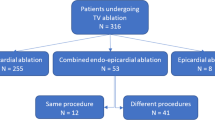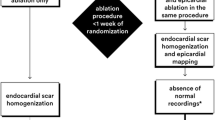Abstract
Objectives
This study analyzes the incidence, characteristics, and ECG morphology of ventricular tachycardia (VT) in post-infarction patients undergoing epicardial VT ablation.
Background
Ablation of recurrent VTs in patients with ischemic cardiomyopathy is typically performed endocardially. In rare cases, epicardial access is required to achieve non-inducibility.
Methods and results
The study evaluated the baseline characteristics, procedural data, and ECG morphology of clinical VT in patients undergoing epicardial VT ablation. From the initial 491 patients with coronary heart disease (CHD) and recurrent VTs undergoing ablation at the Heart Center of Leipzig, Germany, between 2012 and 2020, only 39 patients required an additional epicardial access. In 17 patients, the VTs were associated with infarction scar, while the remaining patients had concomitant CHD without infarction-associated scar and were excluded from the analysis. A propensity match study was performed at a 1:2 ratio for these 17 patients, with 34 patients of the initial cohort as a control group to evaluate the differences in baseline characteristics, procedural data, and ECG morphology of the VTs. The specific VT morphology of negative concordance and superior axis in patients with inferior scar as well as the history of VT ablation were independent predictors of the need for epicardial access.
Conclusions
In addition to previous endocardial ablation, VT ECG morphology with negative concordance and superior axis in post-infarction patients with inferior scar predicted the need for epicardial VT ablation.
Zusammenfassung
Zielsetzung
In dieser Studie analysieren wir die Inzidenz, die Charakteristika und die EKG-Morphologie ventrikulärer Tachykardien (VT) bei Postinfarktpatienten, die sich einer epikardialen VT-Ablation unterziehen.
Hintergrund
Die Ablation von rezidivierenden VTs bei Patienten mit ischämischer Kardiomyopathie wird in der Regel endokardial durchgeführt. In seltenen Fällen ist ein epikardialer Zugang erforderlich, um eine nicht-Induzierbarkeit zu erreichen.
Methoden und Ergebnisse
In der Studie wurden die Ausgangscharakteristika, die Verfahrensdaten und die EKG-Morphologie der klinischen VT bei Patienten ausgewertet, die sich einer epikardialen VT-Ablation unterzogen. Von den ursprünglich 491 Patienten mit koronarer Herzkrankheit (KHK) und rezidivierenden VTs, die sich zwischen 2012 und 2020 einer Ablation im Herzzentrum Leipzig unterzogen, benötigten nur 39 Patienten einen zusätzlichen epikardialen Zugang. Bei siebzehn Patienten waren die VTs mit einer Infarktnarbe assoziiert, während die übrigen Patienten eine begleitende KHK ohne Infarktnarbe aufwiesen und aus der Analyse ausgeschlossen wurden. Wir führten eine Propensity-Match-Studie im Verhältnis 1:2 für diese siebzehn Patienten mit 34 Patienten der ursprünglichen Kohorte als Kontrollgruppe durch, um die Unterschiede bei den Ausgangscharakteristika, den Verfahrensdaten und der EKG-Morphologie der VTs zu bewerten. Die spezifische Morphologie der VT mit negativer Konkordanz und superiorer Achse bei Patienten mit inferiorer Narbe sowie die Vorgeschichte der VT-Ablation waren unabhängige Prädiktoren für die Notwendigkeit eines epikardialen Zugangs.
Schlussfolgerungen
Neben einer vorangegangenen endokardialen Ablation war die EKG-Morphologie der VT mit negativer Konkordanz und superiorer Achse bei Postinfarktpatienten mit inferiorer Narbe ein Prädiktor für die Notwendigkeit einer epikardialen VT-Ablation.

Similar content being viewed by others
Abbreviations
- CABG:
-
Coronary artery bypass grafting
- CHD:
-
Coronary heart disease
- CI:
-
Confidence interval
- ECG:
-
Electrocardiogram
- NYHA:
-
New York Heart Association
- LA:
-
Left atrium
- LV-EDV:
-
Left-ventricular end-diastolic volume
- LV-EF:
-
Left-ventricular ejection fraction
- OR:
-
Odds ratio
- PCI:
-
Percutaneous coronary intervention
- VT:
-
Ventricular tachycardia
References
Marchlinski FE, Haffajee CI, Beshai JF, Dickfeld TL, Gonzalez MD, Hsia HH, Schuger CD, Beckman KJ, Bogun FM, Pollak SJ, Bhandari AK (2016) Long-term success of irrigated radiofrequency catheter ablation of sustained ventricular tachycardia: post-approval THERMOCOOL VT trial. J Am Coll Cardiol 67(6):674–683
Stevenson WG, Soejima K (2007) Catheter ablation for ventricular tachycardia. Circulation 115(21):2750–2760
Wit AL (2001) Remodeling of cardiac gap junctions: the relationship to the genesis of ventricular tachycardia. J Electrocardiol 34:77–83
Silberbauer J, Oloriz T, Maccabelli G, Tsiachris D, Baratto F, Vergara P, Mizuno H, Bisceglia C, Marzi A, Sora N, Guarracini F, Radinovic A, Cireddu M, Sala S, Gulletta S, Paglino G, Mazzone P, Trevisi N, Della Bella P (2014) Noninducibility and late potential abolition: a novel combined prognostic procedural end point for catheter ablation of postinfarction ventricular tachycardia. Circ Arrhythm Electrophysiol 7(3):424–435
Di Biase L, Burkhardt JD, Lakkireddy D, Carbucicchio C, Mohanty S, Mohanty P, Trivedi C, Santangeli P, Bai R, Forleo G, Horton R, Bailey S, Sanchez J, Al-Ahmad A, Hranitzky P, Gallinghouse GJ, Pelargonio G, Hongo RH, Beheiry S, Hao SC, Reddy M, Rossillo A, Themistoclakis S, Dello Russo A, Casella M, Tondo C, Natale A (2015) Ablation of stable VTs versus substrate ablation in ischemic cardiomyopathy: the VISTA randomized multicenter trial. J Am Coll Cardiol 66(25):2872–2882
Sarkozy A, Tokuda M, Tedrow UB, Sieria J, Michaud GF, Couper GS, John R, Stevenson WG (2013) Epicardial ablation of ventricular tachycardia in ischemic heart disease. Circ Arrhythm Electrophysiol 6(6):1115–1122
Hayashi T, Liang JJ, Muser D, Shirai Y, Enriquez A, Garcia FC, Supple GE, Schaller RD, Frankel DS, Lin D, Nazarian S, Zado ES, Arkles JS, Dixit S, Callans DJ, Marchlinski FE, Santangeli P (2018) Epicardial ventricular tachycardia in ischemic cardiomyopathy: prevalence, electrophysiological characteristics, and long-term ablation outcomes. J Cardiovasc Electrophysiol 29(11):1530–1539
Acosta J, Fernández-Armenta J, Penela D, Andreu D, Borras R, Vassanelli F, Korshunov V, Perea RJ, de Caralt TM, Ortiz JT, Fita G, Sitges M, Brugada J, Mont L, Berruezo A (2016) Infarct transmurality as a criterion for first-line endo-epicardial substrate-guided ventricular tachycardia ablation in ischemic cardiomyopathy. Heart Rhythm 13(1):85–95
Darma A, Bertagnolli L, Dinov B, Torri F, Shamloo AS, Lurz JA, Dagres N, Husser-Bollmann D, Bollmann A, Hindricks G, Arya A (2020) Predictors of long-term mortality after catheter ablation of ventricular tachycardia in a contemporary cohort of patients with structural heart disease. Europace 22(11):1672–1679
Tschabrunn CM, Roujol S, Nezafat R, Faulkner-Jones B, Buxton AE, Josephson ME, Anter E (2016) A swine model of infarct-related reentrant ventricular tachycardia: electroanatomic, magnetic resonance, and histopathological characterization. Heart Rhythm 13(1):262–273
Arenal A, Pérez-David E, Avila P, Fernández-Portales J, Crisóstomo V, Báez C, Jiménez-Candil J, Rubio-Guivernau JL, Ledesma-Carbayo MJ, Loughlin G, Bermejo J, Sánchez-Margallo FM, Fernández-Avilés F (2014) Noninvasive identification of epicardial ventricular tachycardia substrate by magnetic resonance-based signal intensity mapping. Heart Rhythm 11(8):1456–1464
Izquierdo M, Sánchez-Gómez JM, Ferrero de Loma-Osorio A, Martínez A, Bellver A, Peláez A, Núñez J, Núñez C, Chorro J, Ruiz-Granell R (2015) Endo-epicardial versus only-endocardial ablation as a first line strategy for the treatment of ventricular tachycardia in patients with ischemic heart disease. Circ Arrhythm Electrophysiol 8(4):882–889
Jaïs P, Maury P, Khairy P, Sacher F, Nault I, Komatsu Y, Hocini M, Forclaz A, Jadidi AS, Weerasooryia R, Shah A, Derval N, Cochet H, Knecht S, Miyazaki S, Linton N, Rivard L, Wright M, Wilton SB, Scherr D, Pascale P, Roten L, Pederson M, Bordachar P, Laurent F, Kim SJ, Ritter P, Clementy J, Haïssaguerre M (2012) Elimination of local abnormal ventricular activities: a new end point for substrate modification in patients with scar-related ventricular tachycardia. Circulation 125(18):2184–2196
Di Biase L, Santangeli P, Burkhardt DJ, Bai R, Mohanty P, Carbucicchio C, Dello Russo A, Casella M, Mohanty S, Pump A, Hongo R, Beheiry S, Pelargonio G, Santarelli P, Zucchetti M, Horton R, Sanchez JE, Elayi CS, Lakkireddy D, Tondo C, Natale A (2012) Endo-epicardial homogenization of the scar versus limited substrate ablation for the treatment of electrical storms in patients with ischemic cardiomyopathy. J Am Coll Cardiol 60(2):132–141
Tung R, Michowitz Y, Yu R, Mathuria N, Vaseghi M, Buch E, Bradfield J, Fujimura O, Gima J, Discepolo W, Mandapati R, Shivkumar K (2013) Epicardial ablation of ventricular tachycardia: an institutional experience of safety and efficacy. Heart Rhythm 10(4):490–498
Romero J, Cerrud-Rodriguez RC, Di Biase L, Diaz JC, Alviz I, Grupposo V, Cerna L, Avendano R, Tedrow U, Natale A, Tung R, Kumar S (2019) Combined endocardial-epicardial versus endocardial catheter ablation alone for ventricular tachycardia in structural heart disease: a systematic review and meta-analysis. JACC Clin Electrophysiol 5(1):13–24
Soto-Iglesias D, Acosta J, Penela D, Fernández-Armenta J, Cabrera M, Martínez M, Vassanelli F, Alcaine A, Linhart M, Jáuregui B, Efimova E, Perea RJ, Prat-González S, Ortiz-Pérez JT, Bosch X, Mont L, Camara O, Berruezo A (2018) Image-based criteria to identify the presence of epicardial arrhythmogenic substrate in patients with transmural myocardial infarction. Heart Rhythm 15(6):814–821
Andreu D, Ortiz-Pérez JT, Boussy T, Fernández-Armenta J, de Caralt TM, Perea RJ, Prat-González S, Mont L, Brugada J, Berruezo A (2014) Usefulness of contrast-enhanced cardiac magnetic resonance in identifying the ventricular arrhythmia substrate and the approach needed for ablation. Eur Heart J 35(20):1316–1326
Reithmann C, Herkommer B, Fiek M (2016) Epicardial ventricular tachycardia substrate visualized by magnetic resonance imaging: need for a transpericardial ablation approach? Clin Res Cardiol 105(10):827–837
Alyesh DM, Siontis KC, Sharaf Dabbagh G, Yokokawa M, Njeim M, Patel S, Morady F, Bogun F (2019) Postinfarction myocardial calcifications on cardiac computed tomography: implications for mapping and ablation in patients with nontolerated ventricular tachycardias. Circ Arrhythm Electrophysiol 12(5):e7023
Liang JJ, Nazarian S, Dixit S (2019) Role of calcification in patients with healed infarcts experiencing ventricular tachycardia: concrete wall, steel slat, or merely a fence? Circ Arrhythm Electrophysiol 12(5):e7349
Ling Z, Hari A, Tandri H (2014) VT ablation: new developments and approaches. Curr Treat Options Cardiovasc Med 16(4):297
Svenson RH, Littmann L, Gallagher JJ, Selle JG, Zimmern SH, Fedor JM, Colavita PG (1990) Termination of ventricular tachycardia with epicardial laser photocoagulation: a clinical comparison with patients undergoing successful endocardial photocoagulation alone. J Am Coll Cardiol 15(1):163–170
Yoshiga Y, Mathew S, Wissner E, Tilz R, Fuernkranz A, Metzner A, Rillig A, Konstantinidou M, Igarashi M, Kuck KH, Ouyang F (2012) Correlation between substrate location and ablation strategy in patients with ventricular tachycardia late after myocardial infarction. Heart Rhythm 9(8):1192–1199
Piers SR, Silva Mde R, Kapel GF, Trines SA, Schalij MJ, Zeppenfeld K (2014) Endocardial or epicardial ventricular tachycardia in nonischemic cardiomyopathy? The role of 12-lead ECG criteria in clinical practice. Heart Rhythm 11(6):1031–1039
Reithmann C, Fiek M, Aynur Z, Ulbrich M (2019) Electrocardiographic criteria of epicardial ventricular tachycardia with anterior origin. Clin Res Cardiol 108(3):254–263
Sosa E, Scanavacca M, d’Avila A, Oliveira F, Ramires JA (2000) Nonsurgical transthoracic epicardial catheter ablation to treat recurrent ventricular tachycardia occurring late after myocardial infarction. J Am Coll Cardiol 35(6):1442–1449
Della Bella P, Brugada J, Zeppenfeld K, Merino J, Neuzil P, Maury P, Maccabelli G, Vergara P, Baratto F, Berruezo A, Wijnmaalen AP (2011) Epicardial ablation for ventricular tachycardia: a European multicenter study. Circ Arrhythm Electrophysiol 4(5):653–659
Sacher F, Roberts-Thomson K, Maury P, Tedrow U, Nault I, Steven D, Hocini M, Koplan B, Leroux L, Derval N, Seiler J, Wright MJ, Epstein L, Haissaguerre M, Jais P, Stevenson WG (2010) Epicardial ventricular tachycardia ablation a multicenter safety study. J Am Coll Cardiol 55(21):2366–2372
Author information
Authors and Affiliations
Corresponding author
Ethics declarations
Conflict of interest
A. Darma, L. Bertagnolli, B. Dinov, F. Torri, N. Dagres, A. Bollmann, G. Hindricks, and A. Arya declare that they have no competing interests.
For this article no studies with human participants or animals were performed by any of the authors. All studies performed were in accordance with the ethical standards indicated in each case.
Additional information
Data Availability Statement
The data that support the findings of this study are available from the corresponding author upon reasonable request.

Scan QR code & read article online
Rights and permissions
About this article
Cite this article
Darma, A., Bertagnolli, L., Dinov, B. et al. A novel ECG finding in patients with epicardial infarct-associated ventricular tachycardia: a case series. Herzschr Elektrophys 33, 217–223 (2022). https://doi.org/10.1007/s00399-022-00849-9
Received:
Accepted:
Published:
Issue Date:
DOI: https://doi.org/10.1007/s00399-022-00849-9
Keywords
- VT in post-infarction patients
- Epicardial ablation
- Inferior scar
- ECG morphology in VT
- Calcification postinfarct




